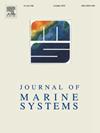2001 ~ 2023年渤海海冰面积的近期减少
IF 2.5
3区 地球科学
Q2 GEOSCIENCES, MULTIDISCIPLINARY
引用次数: 0
摘要
渤海是中国最北端的海域,冬季会出现海冰,影响航运、港口、海水养殖和基础设施,同时也是斑海豹的重要栖息地。监测海冰变化对海洋经济和生态可持续性都至关重要。本研究利用少云和无云的MODIS卫星影像,采用基于样本的面向对象特征提取方法,结合目视解译校正,构建了2001 - 2023年渤海海冰面积的日(不连续)时间序列。从2001-2010年到2011-2023年,平均海冰面积减少了0.15 × 104 km2(16.36%)。较长的初始冻结期(~ 5周)和较短的融化期(~ 3周)在日平均海冰面积变化中表现出不对称的单峰型。严寒期持续近6周,通常在1月底或2月初达到高峰。从空间上看,海冰冻结频率由北向南、近岸向近海递减,40%以上的频率集中在辽东湾北部和东部沿海。海冰冻结频率每像元的总体趋势为下降56.98%,平均下降幅度为- 0.16%。辽东湾(- 0.25%)和渤海湾(- 0.10%)冻结频率呈下降趋势,莱州湾略有上升(0.02%)。气温、北风和地表感热通量等局地气候因子在渤海海冰变化中起重要作用,AO (r = - 0.71, p <;0.01)和NAO (r = - 0.61, p <;0.01)指数是重要的大尺度气候因子。本文章由计算机程序翻译,如有差异,请以英文原文为准。
Recent decline of sea ice area in the Bohai Sea over the period 2001 to 2023
The Bohai Sea, China's northernmost sea, experiences sea ice during winter that impacts shipping, ports, mariculture, and infrastructure, while also serving as vital habitat for the spotted seal. Monitoring sea ice variability is crucial for both marine economic and ecological sustainability. This study utilizes MODIS satellite images with minimal or no cloud cover and employs a sample-based object-oriented feature extraction method, along with visual interpretation corrections, to construct a daily (though discontinuous) time series of sea ice area in the Bohai Sea from 2001 to 2023. The average sea ice area decreased by 0.15 × 104 km2 (16.36 %) from 2001–2010 to 2011–2023. The longer initial freezing period (∼5 weeks) and shorter melting period (∼3 weeks) show an asymmetric unimodal pattern in daily average sea ice area variation. The severe freezing phase lasts nearly 6 weeks, typically reaching its peak in late January or early February. Spatially, sea ice freezing frequency decreases from north to south and nearshore to offshore, with frequencies above 40 % concentrated along the northern and eastern coasts of Liaodong Bay. The overall trend of sea ice freezing frequency per pixel shows a decline in 56.98 % of the entire sea area, with an average rate of −0.16 %. The trend of freezing frequency is declining in Liaodong Bay (−0.25 %) and Bohai Bay (−0.10 %) but slightly increasing in Laizhou Bay (0.02 %). Local climate factors, including air temperature, northward wind, and surface sensible heat flux, play a crucial role in sea ice variation in the Bohai Sea, while the AO (r = −0.71, p < 0.01) and NAO (r = −0.61, p < 0.01) indices serve as important large-scale climatic factors.
求助全文
通过发布文献求助,成功后即可免费获取论文全文。
去求助
来源期刊

Journal of Marine Systems
地学-地球科学综合
CiteScore
6.20
自引率
3.60%
发文量
81
审稿时长
6 months
期刊介绍:
The Journal of Marine Systems provides a medium for interdisciplinary exchange between physical, chemical and biological oceanographers and marine geologists. The journal welcomes original research papers and review articles. Preference will be given to interdisciplinary approaches to marine systems.
 求助内容:
求助内容: 应助结果提醒方式:
应助结果提醒方式:


